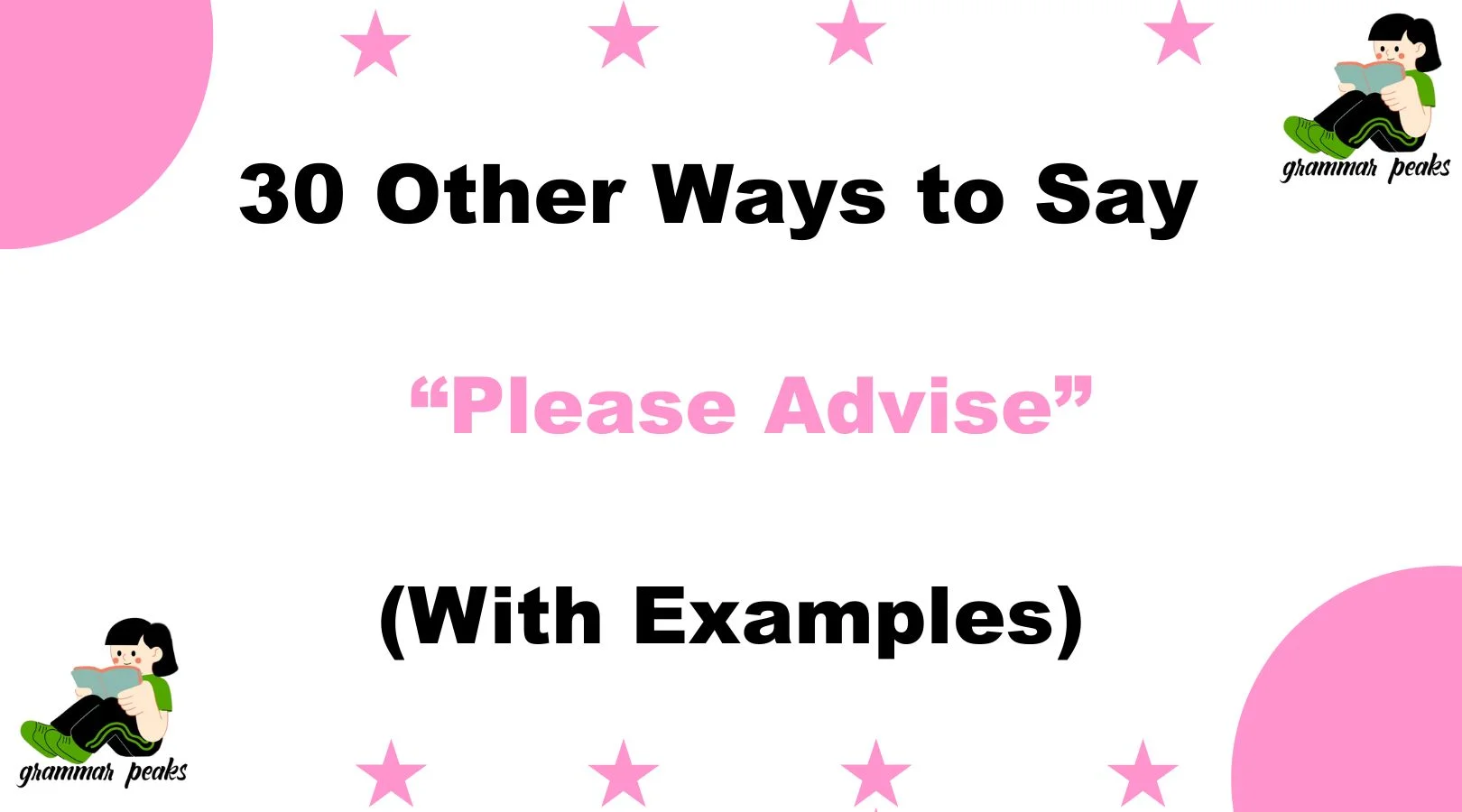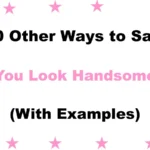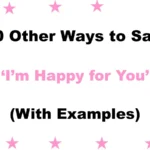Choosing the right words matters—especially when you’re asking for help or guidance. The phrase “please advise” is commonly used in professional emails, but it can sometimes feel cold, demanding, or impersonal. Whether you’re writing to a colleague, supervisor, or client, using more empathetic, thoughtful language can help create trust, warmth, and connection.
In this guide, you’ll discover 30 human-centred alternatives to “please advise” that maintain clarity and professionalism while sounding more genuine and approachable. Let’s explore better ways to express requests with care and clarity.
What Does “Please Advise” Mean?
The phrase “please advise” is a commonly used expression in professional emails and messages, typically used to request guidance, clarification, or direction from the recipient. It signals that the sender needs help making a decision or taking the next step.
While it’s brief and to the point, it can sometimes feel formal, vague, or impersonal, especially if used without context or warmth.
When to Use “Please Advise”
Use this phrase when:
- You’re requesting guidance or a decision.
- The situation is formal or hierarchical (like speaking to leadership).
- You need to keep your message brief and efficient.
Avoid it when you’re aiming for a collaborative, friendly, or emotionally intelligent tone.
Is It Professional/Polite to Say “Please Advise”?
Yes, but it depends on context and tone.
“Please advise” is technically polite and professional. However, it can sometimes sound demanding or impersonal—especially if the rest of the message lacks warmth. It’s best used when you need a quick, formal response, and even better when you pair it with a friendly opener or softening language.
Pros and Cons of Saying “Please Advise”
Pros:
- Clear and concise.
- Universally understood in business settings.
- Efficient when you need a decision.
Cons:
- May sound impersonal or curt.
- Can be misinterpreted as passive-aggressive.
- Lacks emotional warmth or collaborative tone.
Synonyms for “Please Advise”
- Could you let me know what you think?
- I’d appreciate your guidance.
- What would you recommend?
- Your input would be helpful.
- I’d love your thoughts on this.
- How would you suggest we move forward?
- Please share your opinion.
- Can you point me in the right direction?
- Do you have any advice?
- What’s your take?
- Could you weigh in?
- Any suggestions would be great.
- I’d be grateful for your direction.
- Please let me know your thoughts.
- Happy to hear your recommendations.
- What do you suggest?
- Looking forward to your feedback.
- Open to any ideas you have.
- Can you guide me on this?
- Do you have a preferred approach?
- What would be your next step?
- Would love your advice.
- Appreciate any input you may have.
- Please let me know how you’d handle this.
- I welcome your feedback.
- Feel free to share your insights.
- What are your thoughts?
- Kindly let me know what you suggest.
- Would you mind sharing your view?
- I value your opinion—how should we proceed?
1. Could you let me know what you think?
Definition: A polite question inviting someone’s opinion.
Detailed Explanation: This phrase is friendly and open-ended. It invites the recipient to offer their thoughts without pressure.
Scenario Example: I’ve outlined the initial steps for the project. Could you let me know what you think?
Best Use: Team emails, collaborative projects, creative discussions.
Worst Use: Legal or contractual matters needing firm direction.
Tone: Warm, conversational, inviting.
2. I’d appreciate your guidance.
Definition: A respectful way of requesting advice or direction.
Detailed Explanation: This phrase expresses gratitude while gently asking for help. It softens the request and shows humility.
Scenario Example: There are a few options to consider here. I’d appreciate your guidance.
Best Use: Asking a mentor, manager, or expert.
Worst Use: Simple yes/no situations that don’t require actual guidance.
Tone: Respectful, deferential, sincere.
3. What would you recommend?
Definition: A direct yet polite way to request a suggestion or solution.
Detailed Explanation: This phrase respectfully invites the other person’s expertise, perfect when you’re seeking actionable next steps.
Scenario Example: We’re stuck between two strategies. What would you recommend?
Best Use: When seeking an expert’s or senior colleague’s advice.
Worst Use: When a decision is already made or you’re not open to alternatives.
Tone: Respectful, professional, sincere.
4. Your input would be helpful.
Definition: Acknowledges the value of the recipient’s perspective.
Detailed Explanation: This phrase communicates trust in the other person’s knowledge without demanding a response.
Scenario Example: Before finalizing the report, your input would be helpful.
Best Use: When you’re collaborating and want to show openness.
Worst Use: When addressing someone who isn’t involved or familiar with the context.
Tone: Inclusive, polite, appreciative.
5. I’d love your thoughts on this.
Definition: An open, warm invitation for someone’s opinion.
Detailed Explanation: This version is friendly and less formal—ideal for collaborative environments.
Scenario Example: Here’s the revised concept. I’d love your thoughts on this.
Best Use: Creative teams, peer-to-peer communication.
Worst Use: Highly formal legal or financial settings.
Tone: Casual, enthusiastic, inviting.
6. How would you suggest we move forward?
Definition: A polite way to ask for direction or a decision path.
Detailed Explanation: This phrase encourages a collaborative tone while also nudging a decision.
Scenario Example: We’ve outlined the issues. How would you suggest we move forward?
Best Use: Team leadership or project planning discussions.
Worst Use: Simple matters that don’t require a forward-thinking strategy.
Tone: Constructive, cooperative, future-oriented.
7. Please share your opinion.
Definition: A straightforward way to invite someone’s views.
Detailed Explanation: Though formal, this request acknowledges the recipient’s perspective without sounding commanding.
Scenario Example: We’ve compiled the draft policy. Please share your opinion.
Best Use: When collecting feedback or edits from peers.
Worst Use: When time is too limited for in-depth input.
Tone: Neutral, respectful, professional.
8. Can you point me in the right direction?
Definition: A friendly, informal way of asking for guidance.
Detailed Explanation: This metaphorical phrase makes the request sound human and down-to-earth.
Scenario Example: I’m not sure how to handle this request. Can you point me in the right direction?
Best Use: In emails with supervisors, mentors, or internal team members.
Worst Use: In formal proposals or external client communications.
Tone: Friendly, humble, collaborative.
9. Do you have any advice?
Definition: A simple and humble question seeking counsel.
Detailed Explanation: This alternative shows vulnerability and openness, ideal for mentorship situations.
Scenario Example: I’ve handled a similar situation once, but do you have any advice?
Best Use: Personal professional growth, new situations.
Worst Use: Where directive input is urgently required.
Tone: Personal, respectful, open.
10. What’s your take?
Definition: Casual phrasing for “What’s your opinion?”
Detailed Explanation: This relaxed phrase is useful when writing to someone familiar or on the same level.
Scenario Example: The vendor changed pricing again—what’s your take?
Best Use: Internal chats, informal work emails.
Worst Use: Formal reports, external correspondence.
Tone: Casual, approachable, direct.
11. Could you weigh in?
Definition: A compact, professional way of asking for input.
Detailed Explanation: Useful in group discussions or threads where the person’s opinion would add value.
Scenario Example: We’re discussing launch timelines—could you weigh in?
Best Use: Multi-party conversations, brainstorming.
Worst Use: Requests that need urgent action or clarity.
Tone: Professional, collaborative.
12. Any suggestions would be great.
Definition: Softens the request and shows you’re open to help.
Detailed Explanation: A low-pressure way to ask for ideas, often used in casual professional exchanges.
Scenario Example: We’re reworking the layout—any suggestions would be great.
Best Use: Creative teams, early-stage planning.
Worst Use: Legal or regulated environments.
Tone: Friendly, open, collaborative.
13. I’d be grateful for your direction.
Definition: Shows humility and appreciation while asking for input.
Detailed Explanation: This formal yet emotional phrase is ideal for showing gratitude upfront.
Scenario Example: This is new territory for me—I’d be grateful for your direction.
Best Use: Mentor-mentee conversations, senior management requests.
Worst Use: Everyday, low-impact emails.
Tone: Sincere, professional, deferential.
14. Please let me know your thoughts.
Definition: A polite and classic way of requesting feedback.
Detailed Explanation: It maintains professionalism while encouraging collaboration.
Scenario Example: I’ve attached the proposal—please let me know your thoughts.
Best Use: Peer or client check-ins.
Worst Use: When needing strict or urgent direction.
Tone: Balanced, polite, welcoming.
15. Happy to hear your recommendations.
Definition: Signals openness and enthusiasm for someone’s ideas.
Detailed Explanation: Great for working relationships that value contribution and teamwork.
Scenario Example: We’re shaping next week’s agenda—happy to hear your recommendations.
Best Use: Collaborative settings, team planning.
Worst Use: When you’re not truly open to changes.
Tone: Positive, open-minded, enthusiastic.
16. What do you suggest?
Definition: A straightforward request for a proposed solution.
Detailed Explanation: A direct question that seeks resolution or decision.
Scenario Example: Given the delay, what do you suggest we do next?
Best Use: Time-sensitive decisions, problem-solving.
Worst Use: When options are already predetermined.
Tone: Direct, respectful, action-driven.
17. Looking forward to your feedback.
Definition: A polite closing that encourages a response.
Detailed Explanation: Best used at the end of an email to subtly nudge for input.
Scenario Example: Please find the draft attached—looking forward to your feedback.
Best Use: Polished correspondence, client-facing emails.
Worst Use: Casual requests that don’t need detailed feedback.
Tone: Polite, expectant, courteous.
18. Open to any ideas you have.
Definition: Shows flexibility and invites creativity.
Detailed Explanation: Great when brainstorming or inviting different perspectives.
Scenario Example: We’re trying something new—open to any ideas you have.
Best Use: Creative work, collaborative settings.
Worst Use: Regulated or policy-bound discussions.
Tone: Friendly, flexible, collaborative.
19. Can you guide me on this?
Definition: A respectful ask for support or mentorship.
Detailed Explanation: Implies you trust the recipient’s expertise and are seeking help.
Scenario Example: This client request is unusual—can you guide me on this?
Best Use: Career development, learning situations.
Worst Use: Where action is more important than learning.
Tone: Sincere, respectful, thoughtful.
20. Do you have a preferred approach?
Definition: Invites someone’s leadership or style into the decision.
Detailed Explanation: Useful when working with supervisors or decision-makers.
Scenario Example: Before we finalize, do you have a preferred approach?
Best Use: Teamwork with managers, project planning.
Worst Use: Informal group discussions.
Tone: Polished, respectful, deferential.
21. What would be your next step?
Definition: A strategic way to ask for directional input based on someone’s experience.
Detailed Explanation: This phrase is excellent when you’re unsure of what to do and want to learn from someone’s problem-solving process.
Scenario Example: We’ve hit a bit of a snag—what would be your next step?
Best Use: Mentoring conversations, planning meetings, strategic brainstorming.
Worst Use: When the next step is already clearly defined.
Tone: Inquisitive, respectful, learning-oriented.
22. Would love your advice.
Definition: An informal, heartfelt way to request support or guidance.
Detailed Explanation: Short and warm, this phrase works best in trusting relationships or team dynamics.
Scenario Example: I’m considering switching the timeline—would love your advice.
Best Use: Internal teams, friendly professional settings, informal mentorship.
Worst Use: High-stakes or highly formal environments.
Tone: Genuine, warm, friendly.
23. Appreciate any input you may have.
Definition: A soft and grateful request for feedback or ideas.
Detailed Explanation: It communicates openness without demanding a reply, which makes it low-pressure and polite.
Scenario Example: I’ve made some edits to the design—appreciate any input you may have.
Best Use: Group projects, team collaboration, feedback loops.
Worst Use: When decisive direction is urgently needed.
Tone: Humble, appreciative, open.
24. Please let me know how you’d handle this.
Definition: Invites the recipient to share their own approach.
Detailed Explanation: It personalizes the request and shows you value their unique style or experience.
Scenario Example: This client wants a last-minute revision—please let me know how you’d handle this.
Best Use: Learning scenarios, one-on-one communication with mentors or supervisors.
Worst Use: Routine tasks with clearly defined steps.
Tone: Respectful, personal, engaging.
25. I welcome your feedback.
Definition: A warm and professional way to invite insights.
Detailed Explanation: It shows emotional intelligence and openness to improvement without sounding demanding.
Scenario Example: The policy draft is ready—I welcome your feedback.
Best Use: Reviews, collaborative editing, internal reports.
Worst Use: In time-sensitive, urgent situations where action is more important than opinion.
Tone: Courteous, mature, thoughtful.
26. Feel free to share your insights.
Definition: An easy-going phrase that invites feedback without pressure.
Detailed Explanation: This makes the invitation sound casual and non-intrusive, suitable for peer-level conversations.
Scenario Example: This is a rough first draft—feel free to share your insights.
Best Use: Team discussions, brainstorming sessions, informal reviews.
Worst Use: Formal proposals or urgent decision-making.
Tone: Casual, inviting, light-hearted.
27. What are your thoughts?
Definition: A concise and balanced way to seek someone’s opinion.
Detailed Explanation: This phrase is both approachable and professional, making it great for all kinds of workplace communication.
Scenario Example: Here’s the updated proposal—what are your thoughts?
Best Use: All-purpose emails, peer conversations, supervisor discussions.
Worst Use: Where more direct, instructional feedback is required.
Tone: Neutral, professional, conversational.
28. Kindly let me know what you suggest.
Definition: A slightly more formal way to request advice or input.
Detailed Explanation: The word “kindly” adds politeness, making this suitable for emails where tone matters.
Scenario Example: We’re re-evaluating the workflow—kindly let me know what you suggest.
Best Use: Formal requests, client or supervisor correspondence.
Worst Use: Internal chats or relaxed communication.
Tone: Polite, formal, respectful.
29. Would you mind sharing your view?
Definition: A gentle and respectful way to invite someone’s opinion.
Detailed Explanation: This phrase emphasizes the other person’s autonomy while showing you value their thoughts.
Scenario Example: Before we move ahead, would you mind sharing your view?
Best Use: Cross-functional collaboration, new projects, client communications.
Worst Use: Quick decisions or rigid instructions.
Tone: Courteous, soft, diplomatic.
30. I value your opinion—how should we proceed?
Definition: Expresses appreciation while directly requesting a recommendation.
Detailed Explanation: It validates the recipient’s insight and encourages them to take the lead on next steps.
Scenario Example: We’ve looked at all the data—I value your opinion. How should we proceed?
Best Use: Strategic decisions, senior input, collaborative decisions.
Worst Use: Situations where hierarchy requires your own decision.
Tone: Warm, respectful, professional.
Conclusion
Choosing how to say “please advise” can make a big difference in how your message is received. While the phrase itself is clear and professional, it sometimes feels too formal or impersonal. By using one of these 30 thoughtful alternatives, you can communicate your request with more warmth, respect, and clarity. Whether you want to sound collaborative, humble, or encouraging, these options help you express care and build stronger connections through your words.
Remember, effective communication is about both what you say and how you say it. Using language that resonates with your audience can lead to better responses and more positive relationships in all your professional interactions.
FAQs
1. Is it rude to say “please advise” in an email?
No, it’s not inherently rude, but it can sometimes come across as too direct or impersonal. Pairing it with a polite tone or using an alternative can soften the request.
2. What is a more polite way to say “please advise”?
Phrases like “I’d appreciate your guidance” or “Could you let me know what you think?” are polite alternatives that invite collaboration and warmth.
3. When should I avoid using “please advise”?
Avoid it in casual conversations or when writing to someone you have a close relationship with, where more natural or friendly language works better.
4. Can these alternatives be used in formal business emails?
Yes, many alternatives such as “Please let me know your thoughts” or “Kindly let me know what you suggest” are perfectly suitable for formal contexts.
5. Does changing how I say “please advise” impact how my message is received?
Absolutely. Thoughtful wording shows emotional intelligence and respect, which often results in more engaged and helpful responses.






